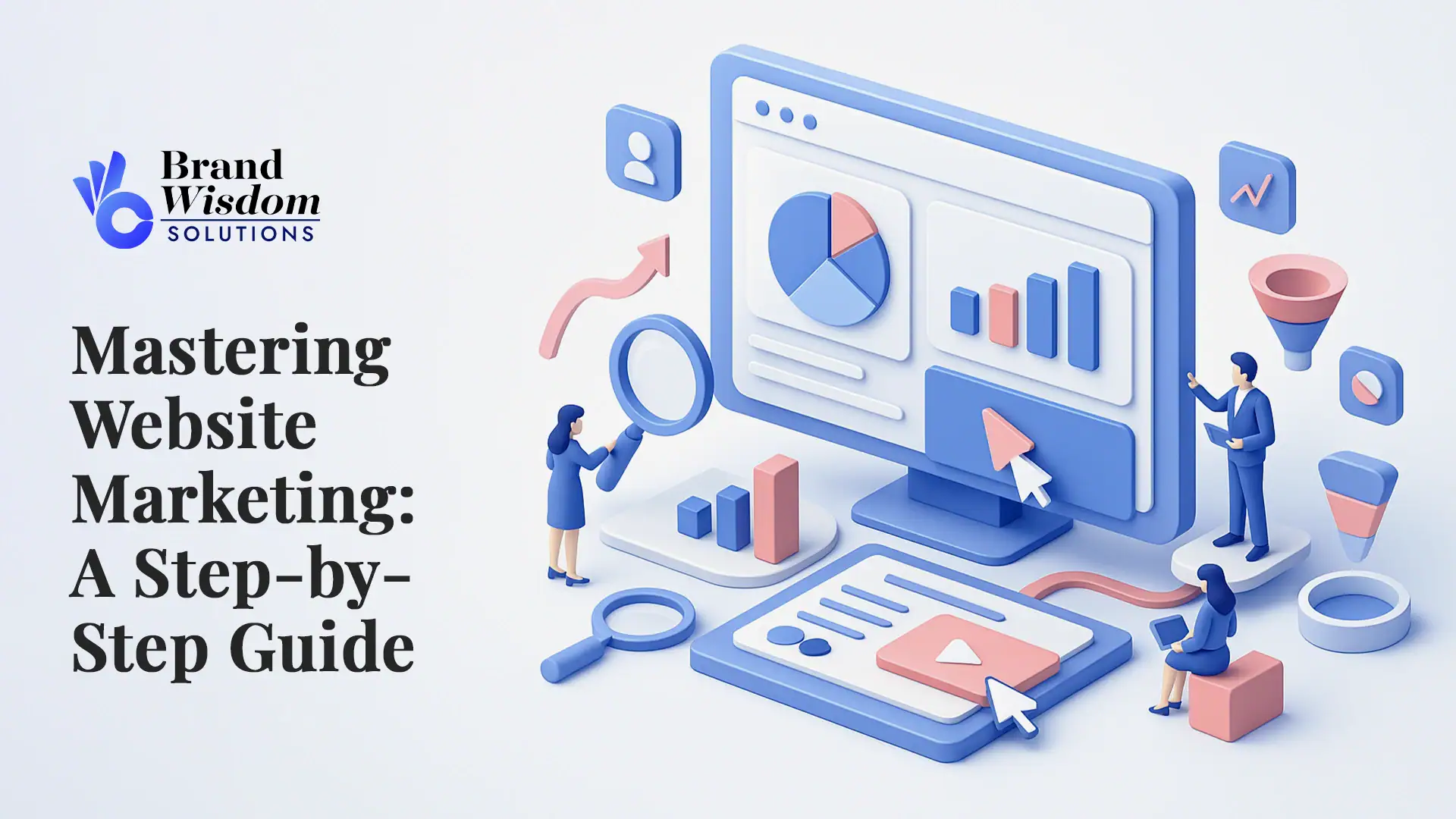In today’s online world, having a strong presence is a must. Digital branding is crucial for bringing out your business’s full potential. It involves creating a brand identity that connects with your target audience on all digital channels. Good digital branding is more than just having a logo or a website. It includes building brand awareness, gaining trust, and creating meaningful connections with your customers in the digital world.
Understanding Digital Branding Basics

Think of digital branding as your business’s way of greeting the world online. It’s the first thing potential customers see, and it shapes how they view your products and services. A strong digital brand can help you stand out from your competitors.
Everything, from your website’s design to how people experience it, is important. Your social media presence and content should all come together to share your brand’s story. With so many internet users and brands competing for attention, having a good branding strategy is key to being noticed and successful.
The Definition and Importance of Digital Branding
Your digital brand is everything that helps people find your business online. It includes your website, social media accounts, content, online reviews, and how people talk about your brand online. It’s not just a logo or tagline; it’s the impression people have when they connect with your business digitally.
A good digital brand helps people recognize your brand, builds trust, and encourages loyalty. When your online presence shows your brand’s values and personality, it connects well with your target audience.
In the end, a strong digital brand leads to real results for your business. By creating a memorable and reliable online presence, you can attract more customers, get more leads, and increase sales.
Digital Branding vs. Traditional Branding: Key Differences
Traditional marketing uses offline channels like print ads, TV commercials, billboards, and direct mail. These methods aim at a large group of people, making it hard to track and measure results. Imagine traditional marketing as throwing a big net into the ocean to catch a few fish.
On the other hand, digital marketing includes all marketing actions that happen online. This covers things like search engine optimization (SEO), social media marketing, email marketing, content marketing, and more. Digital marketing lets businesses directly reach their ideal customers with great targeting options.
The best part of digital marketing is that you can measure it. With advanced analytics tools, you can see how your campaigns perform, track what customers do, and make changes based on data to improve your strategies for the best results.
| Aspect | Digital Branding | Traditional Branding |
|---|---|---|
| Channels Used | SEO, social media, email, content marketing, etc. | Print ads, TV commercials, billboards, direct mail |
| Audience Targeting | Specific and precise targeting | Broad and generalized targeting |
| Measurability | Easy to measure with advanced analytics tools | Difficult to track and measure results |
| Reach | Directly reaches ideal customers | Aims at a large group of people |
| Flexibility | High flexibility to optimize campaigns | Limited flexibility in making changes |
Essential Components of a Strong Digital Brand

A strong digital brand is built from clear pieces that work together to create a good and memorable brand experience. These important parts are the base of your online presence and affect how your target audience sees your business.
Your visual identity includes things like your logo, color palette, and overall look. Your brand messaging and online reputation are also important. Each part works together to create a successful digital brand that connects with your target customers.
Crafting Your Brand’s Visual Identity
Your visual identity is usually the first thing customers see when they find your brand online. It shows what your brand is like, what it stands for, and its key values.
When you choose these elements carefully, like your logo, color palette, typography, and images, they can bring out certain feelings and ideas about your brand. All these parts should fit together well to form a strong and memorable brand experience.
Being consistent is very important. You need to keep the same visual identity in every online space your website, social media, email marketing, and digital advertising. This helps build brand recognition and trust among your audience.
Building Your Online Presence for Visibility
Your online presence is more than just having a website. It is about creating a strong and consistent brand identity everywhere online. This means being active on social media, online directories, industry forums, and any place your target audience visits.
A strong digital brand works well with a good SEO plan. By optimizing your website and content for the right keywords, you can rank higher in search engine results. This helps potential customers find you when they search for products or services like yours.
The main goal is to make your brand easy to find. You want to create a simple and positive experience for everyone who connects with your business online.
Strategies to Enhance Credibility in the Digital Space
In today’s digital world, trust is very important. Consumers are careful and do research before they buy anything. To gain credibility online, you need to show that your brand is a reliable expert in your field.
One great way to do this is by sharing your knowledge through good, helpful content. This can be blog posts, articles, videos, infographics, or anything else that gives value to your target audience. When you share useful insights, data, and expert opinions, people will see your brand as a helpful resource.
You should also ask customers to leave reviews and testimonials. This builds social proof and shows that you are trustworthy. When potential customers see good reviews from real people, they are more likely to think positively about your brand and what you offer.
A Beginner’s Guide to Starting Your Digital Branding Journey

Starting your journey in digital branding can be tough. This is especially true if you’re new to online marketing and creating a brand. But remember, taking small steps can lead to great results if you keep at it.
This beginner’s guide will help you with easy steps to build a strong online presence. You will learn how to create a brand that connects with the customers you want. So, let’s get started!
What You Need to Get Started
The first step in digital branding is to understand what makes your brand special. You need to define your brand’s mission, values, and the main message you want to share with your target audience. This step helps set the base for your digital branding efforts.
Next, figure out who your target audience is. Think about the people you want to reach with your brand. What are their age, interests, online habits, and challenges? Knowing your target audience is key to creating messages and content that connect with them.
Finally, research your competitors well. Look at their digital branding strategies, who they target, and how they appear online. This gives you helpful information to position your brand and find ways to stand out in the digital market.
Step 1: Identifying Your Brand’s Core Values and Target Audience
Defining your brand’s core values is very important. These values help you make decisions and shape your brand’s identity.
After you know your core values, you should find your target audience. Think about who will benefit most from your products or services. Creating detailed buyer personas can help you learn about their age, interests, habits, and problems.
Once you understand your core values and target audience, you can focus on brand positioning. How do you want customers to see your brand compared to your competitors? Your brand positioning statement should clearly explain your unique value and what makes you different in the market.
Step 2: Designing a Distinctive Logo and Brand Palette
Your logo is very important for your brand identity. A good logo should be easy to remember, work in different sizes, and show your brand’s personality and values. It’s a good idea to hire a professional designer to help create a logo that represents your brand well.
After making your logo, focus on choosing a color scheme that matches your brand identity. Colors can create feelings and ideas, so pick them carefully. Use your color palette consistently on all your digital platforms, such as your website and social media graphics.
Be sure to keep everything looking the same when it comes to visual identity. Make sure your logo, color scheme, typography, and overall style are the same on all your online platforms.
Step 3: Developing a Compelling Brand Message
Your brand message is how you share what your brand is all about. It shows your value, personality, and core idea to your target audience. To create a strong brand message, make a short and catchy statement that your ideal customers will connect with.
Think about your brand’s tone of voice. Is it formal, informal, playful, or serious? The tone of voice should match your brand’s personality and attract your target audience.
Make sure your brand messaging stays the same online. This includes your website content, social media posts, email marketing, and even how you interact with customers.
Step 4: Creating a Responsive, User-Friendly Website
Your website is your online shop, so it must make a good first impression. A well-made website looks nice, is easy to use, and gives a smooth experience for visitors. It should load fast, work well on mobile devices, and have good content that fits your target audience.
When you design your website, think about the user experience (UX). This means making it simple for visitors to find what they want. Use clear and easy language, attractive images, and a simple site layout to improve the UX.
Also, remember to optimize your site for search engines (SEO). This means using important keywords in your content, meta descriptions, and image alt tags to help your site show up better in search engine results pages (SERPs).
Step 5: Establishing a Strong Social Media Presence
Social media platforms are great for connecting with your target audience. They help you build relationships and promote your brand. Find out which platforms your target audience uses the most. Then, focus your efforts on those channels.
Make engaging and shareable media content that fits your brand identity. It should appeal to your audience. This could be images, videos, infographics, blog posts, or live streams. Try different types of content to see what works best.
Social listening is crucial for knowing what your audience wants. Keep an eye on social media discussions, track brand mentions, and connect with your followers. This gives you useful information to improve your social media strategy and adjust your content accordingly.
Implementing Effective Digital Branding Strategies

Building a strong digital brand is a continuous task. It needs regular care and improvement. After you set the basics, you can start using smart strategies to grow your brand’s presence and influence.
Using search engine optimization (SEO) and creating exciting content marketing campaigns are some ways to help you boost your digital brand. These strategies will provide you with the tools you need to reach your business goals.
Leveraging SEO for Increased Visibility
Search engine optimization (SEO) is a key part of any good digital branding strategy. SEO helps improve your online presence like your website and content so they can rank better in search engine results. When your target audience searches for important keywords, you want your brand to show up at the top.
Start by doing detailed keyword research. This helps you find the words and phrases your target audience uses when looking for products or services like yours. After finding these keywords, use them naturally in your website content, meta descriptions, image alt tags, and other parts of your online presence.
SEO is not a one-time task. It needs regular checking, analysis, and changes. Keep up with the latest algorithm changes and the best practices in the industry. This way, your website can stay visible in the changing digital world.
Engaging Content Marketing Strategies to Tell Your Brand’s Story
Content marketing is a strong way to shape your brand’s story and connect with your target audience. By creating useful, relevant, and steady content, you can make your brand seem like a trusted source. This will help you build relationships with potential customers and lead to more sales.
Good content marketing shares your brand’s story in a way that connects with your audience. You can talk about your brand’s journey, values, and mission with stories that touch your customers’ feelings. Think about using these types of content in your marketing plan:
| Blog Posts | Share useful information and insights about your industry. |
| Videos | Make fun video content that shows your products, services, or brand character. |
| Infographics | Show data and information in a visually pleasing and easy way to understand. |
Utilizing Email Marketing to Build Relationships
Email marketing is a great way to connect with leads, build strong links with your customer base, and increase sales. It gives you a chance to talk directly to your audience and adds a personal touch that can help build loyalty.
Start by creating an email list of people who want to hear from you. You can offer special benefits, like exclusive content, discounts, or early access to new products or services, to get more subscribers. Next, divide your email list based on things like age, interests, or buying habits. This will help you send messages that really speak to them.
Make your emails more personal by using the subscriber’s name. Tailor the content to what they like, and give them useful information or offers that meet their needs.
The Role of Paid Advertising in Digital Branding
Paid advertising, also known as online advertising or digital advertising, complements your organic digital branding efforts by amplifying your reach and targeting specific audience segments. Platforms like Google Ads and social media advertising platforms offer various targeting options to reach your ideal customers effectively.
Paid advertising allows you to display your ads to users who are actively searching for products or services like yours. You can target ads based on demographics, interests, online behavior, and more.
Here’s a breakdown of common types of paid advertising:
| Paid Advertising Type | Description |
| Search Ads | Text ads that appear in search engine results pages |
| Display Ads | Image or video ads that appear on websites and apps |
| Social Media Ads | Targeted ads that appear on social media platforms |
| Remarketing Ads | Ads that target users who have previously interacted with your website or brand. |
Analyzing and Adapting Your Digital Brand Strategy

In the fast-changing online world, it is important to analyze and change your digital brand strategy for ongoing success. What worked before may not work as well now, so you need to keep up and accept changes.
Keep an eye on your digital marketing efforts. Collect data on what interests your target audience and make the needed changes. By using data to guide you, you can improve your strategies. This way, your brand stays relevant, engaging, and competitive.
Tools and Techniques for Monitoring Your Brand’s Online Presence
Monitoring your brand’s online presence is very important. It helps you see how your target audience thinks about you. You can also find areas where you need to improve. There are many tools and methods that offer useful insights into your brand’s performance on different digital channels.
Social listening tools let you keep track of brand mentions. You can follow hashtags and understand how people feel about your brand. Google Analytics helps you check your website traffic. It tracks user behavior and measures your content marketing efforts. Also, make sure to pay attention to online reviews. Customers often share their experiences on platforms where you can see what they think.
Review the data you collect from these tools on a regular basis. This way, you can spot trends and learn about customer preferences. You will get insights into areas where you can improve the brand experience. Changing your strategies using these insights is important for making your digital branding efforts better.
Adjusting Your Strategy Based on Analytics and Feedback
Data-driven decision-making is very important in digital marketing. Looking at the data from your online channels gives you great insights. This helps you change your strategy and improve your campaigns for better results.
You should check your website analytics often. This way, you can find your best content, see how users act, and keep track of conversions. Look closely at things like bounce rate, time on site, and conversion rates. These metrics help you understand how good your website design and content are.
You also need to ask for feedback from your audience. Use surveys, polls, social media, or just ask them directly. Listen to what they say, fix any problems, and use their ideas in your plans.
Conclusion
In today’s fast-moving digital world, it is important to get your business’s branding right. This helps in attracting and keeping customers. Knowing the basic ideas of digital branding will help you stand out. You should focus on your key values, your visual identity, and your online presence. This builds trust and makes you more visible. Use SEO, interesting content, email marketing, and paid ads to share your brand’s story. Also, keep checking and adjusting your strategy based on what people say and the data you collect. Are you ready to boost your brand? Get in touch and start your successful digital branding journey today!
Frequently Asked Questions
How Often Should I Update My Digital Branding Strategy?
- Review your branding strategy regularly. It’s best to do this every three months or as your business changes.
- Think about changes in consumer behavior.
- Keep in mind the preferences of your target audience.
- Look at new trends that might affect how your brand develops.
Can Digital Branding Work for Small Businesses in Maharashtra?
The digital world helps all businesses, big or small. It allows small businesses in Maharashtra to connect with more people. Good online marketing and smart brand building can help them stand out in the local area and beyond.
What Are the Biggest Challenges in Digital Branding?
Building brand recognition in a busy online world needs a strong marketing team and the ability to change with the times. Keeping up with search engine updates and handling social media discussions well can be difficult challenges.
How Can I Measure the Success of My Digital Branding Efforts?
- Keep an eye on important numbers like website visits, social media activity, email open rates, and how many people take action.
- Watch how well your brand is known by looking at how marketing campaigns perform, search engine results, and the number of potential customers coming in.





